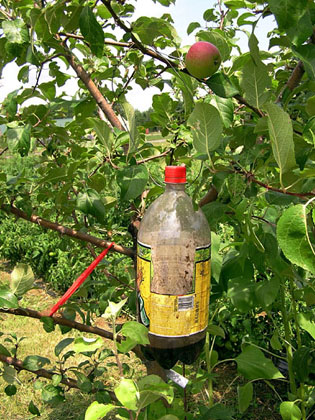 |
| John Bunker coats an apple with Tanglefoot. English photo. |
 |
| Hang about two sticky apples in each tree, at eye level, and prune away nearby branches. The apples trap apple maggot flies. English photo. |
 |
| A soda bottle with a hole cut in the side and molasses and vinegar in the bottom can trap codling moths. English photo. |
By Jean English
“It’s always worth planting trees,” maintains John Bunker, vice president (and president as of 2005) of the Maine Organic Farmers and Gardeners Association (MOFGA) and coordinator of Fedco Trees. “Look at the trees at the Arnold Arboretum [in Jamaica Plain, Mass.] that people planted a hundred years ago. There are oaks that are 3 or 4 feet in diameter … Someone who’s dead now took the time to plant trees for us.”
In Maine, Bunker suggests planting trees – and he was talking specifically about apple trees at MOFGA’s Small Farm Field Day last August – in April and May rather than in the fall, but you can prepare for planting in the fall. First, pick your site. For apple trees, find a spot on a slope, if possible, with good air movement (or “air drainage”). This will help reduce the common fungal diseases of apples in Maine: scab, fly speck and sooty blotch.
If you have well-drained, decent loam, you’re in good shape, even if you have just 18 to 24 inches of loam over hardpan or ledge. If you have sand, add organic matter. Then put a stake in the ground where you’ll plant the tree, and spread soil amendments, such as rock phosphate, aragonite (for calcium) and azomite (for trace minerals), as required, then cover the amendments with compost; or “just dump the compost in a pile, right on top of the grass, or on top of cardboard on the grass. Start a compost pile where you’re going to plant. The soil will be friable by spring. Dig the compost and amendments into the soil in the spring. Using compost, rock powders and mulch can make your soil grow good fruit trees,” said Bunker. His own land in Palermo consists of sandy grit above ledge. Using the above methods, Bunker now has 20- to 25-year-old fruit trees that have produced for a number of years.
Because scab is the worst fungal disease in Maine, you might want to plant a scab resistant variety, such as ‘Liberty.’ Susceptible varieties, such as ‘Macs,’ ‘Cortland,’ ‘Spartan’ and ‘Empire,’ will require fungicides to control scab; organic fungicides are available.
In an existing orchard, remove scabby apples and fallen leaves in the fall or run over the leaves with a lawnmower, or spread compost or lime around the trees to cut down on diseases. “A lime spreader is a good, low-tech tool,” said Bunker. “The pH of lime will kill the scab fungus.” He advised mowing, then liming lightly, then spreading some compost in the fall. “This will certainly reduce scab spores.” Scab looks like round, black dots about the size of the hole made by a hole puncher.
You’ll have to be vigilant for insect pests in the spring and summer, and Bunker suggested ways to get a fruit crop without spraying poisons. SurroundTM is a clay material that can be sprayed on trees. It leaves a light colored residue that irritates insects’ feet and works well on a small scale, although repeated spraying will be necessary if rain washes the clay from the trees. Surround works against plum curculios, but it must be applied by petal fall and remain on the trees until about the end of June. You may need to spray trees (trunks, leaves, etc.) a couple of times at first to build up enough of a clay residue.
Another way to limit curculio damage is to cut a slit in a tarp so that you can spread the tarp on the ground beneath a tree. Then shake the tree at least twice, once in the morning and once in the afternoon. The curculios will drop from the trees onto the tarp and “play dead.”
Codling moths can be trapped by mixing a dollop (or up to a cup) of molasses in a gallon of vinegar and putting a few inches of this solution in the bottom of a soda bottle that has had an opening cut from its side. Hang two or three of these soda bottles on each medium-sized tree, close to fruits, from early June through early September, and codling moths will fly into the bottles and drown in the liquid. Remove the moths every week or so.
To trap apple maggot flies, you can remove old apples from your root cellar or buy apples at the store, put wires through them, coat them with a sticky substance called Tanglefoot, and hang about two of these sticky apples on each tree at eye height. Trim the branches away from this trap so that the flies see it.
Bunker warned orchardists to look for orange “sawdust” at the base of trees. This is the telltale “frass” produced by borers, which tunnel under bark and can kill trees. If you see this frass, look for a small hole on the trunk above it, dig into the hole with a wire or cut a patch out with a sharp knife to find and skewer the borer larva. You can prevent borers from laying eggs on tree trunks by wrapping hardware cloth around the bottom of the trunk.
More details about fruit tree care are in the Fedco Trees catalog (Fedco, PO Box 520, Waterville ME 04903; www.fedcoseeds.com; 207-873-7333). Bunker also suggested reading books about fruit over and over; The Apple Grower by Michael Phillips is one good resource.
